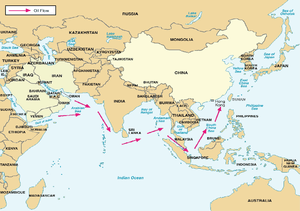Sea lines of communication

Sea lines of communication (abbreviated as SLOC) is a term describing the primary maritime routes between ports, used for trade, logistics and naval forces.[1] It is generally used in reference to naval operations to ensure that SLOCs are open, or in times of war, to close them.
In the American Revolutionary War and the Napoleonic Wars, the SLOCs were, for the most part, in the control of the British Navy. When the British lost control of them during the Revolution, the result was the fall of Yorktown and its biggest army and, ultimately, the war. In the Napoleonic era, maintaining belligerence throughout, the British embargoed and blockaded any country associated with Napoleon, which created large economic hardships and dislocations that ultimately led to the people of France becoming disenchanted with Napoleon.
In World War I and World War II, the Kriegsmarine attempted to close the SLOCs from North America to the British Isles with the use of submarines. In World War I, the British operated a naval blockade of Germany cutting off external trade by sea. In World War II, the Allies engaged in the Battle of the Atlantic, a defensive campaign with escort vessels and convoys to keep the SLOCs open. Also, the US Navy successfully closed the SLOCs to Japan, strangling the resource-poor island nation.
Had the Cold War turned hot, Europe would have required resupply and reinforcement from North America. Soviet Navy strategy was to close the SLOCs to maximize their numerical superiority in Europe.
See also
References
- ↑ Klein, John J. (2007). "Maritime Strategy Should Heed U.S. and UK Classics". U.S. Naval Institute Proceedings. 133 (4): 67–69.